How to Install Windows 8 Alongside Your Current OS
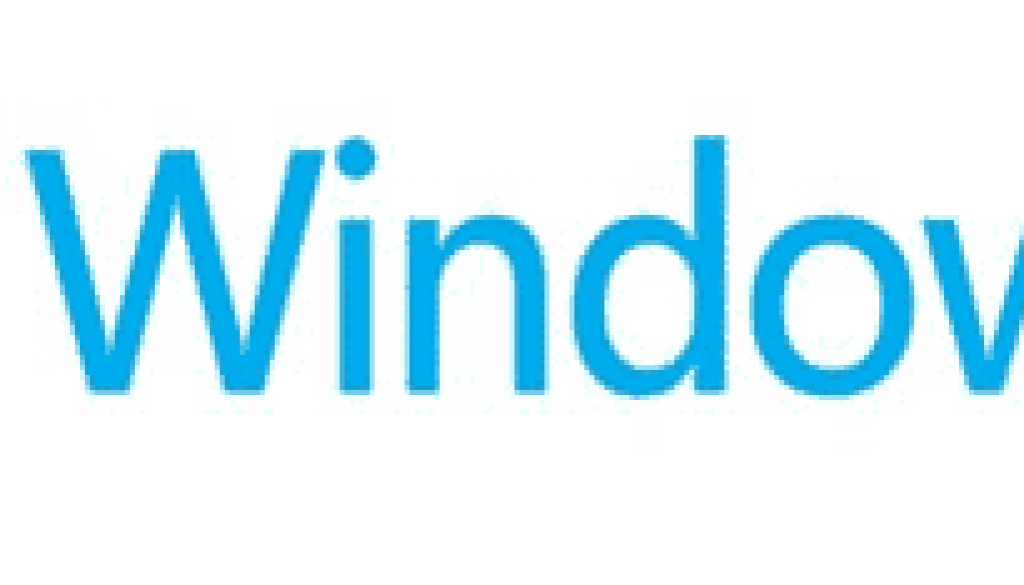
Microsoft released the Windows 8 Consumer Preview on February 29. This version is said to be fairly feature complete, stable and ready for everyone to try.
I wanted to give Windows 8 a try so I can see if the Metro UI would be as silly as I thought, but I didn’t want to overwrite Windows 7 (my current OS), nor did I want to partition my hard drive for it. As such, I figured a virtual machine would be the best way to go. If you want to try Windows 8 and want to be able to easily remove it after you’re done, follow these instructions to set up a Windows 8 Virtual Machine for free on your current computer.
Windows 8 can be installed via a virtual machine on a Windows, Mac or Linux machine, though the steps may vary a little. The steps below are how to set this up on a Windows 7 PC.
1. Download and install VirtualBox
VirtualBox is a great free virtualization program from Oracle for enterprise and home users. It has a nice, easy to use UI, is feature rich and has good performance and stability.
You can download VirtualBox from the project’s website. Be sure to grab the right version for your operating system. Once VirtualBox has been downloaded, install it and you’re ready to go.
2. Download the Windows 8 Consumer Preview
In order to install Windows 8, you’ll need to get the Windows 8 Consumer Preview ISO image, which you can pickup from the Microsoft website. The consumer preview is available in many languages so be sure you grab the language and version (32 or 64 bit) that you want to run. I suggest that when running an operating system as a virtual machine, you always run a 32 bit version.
The download page also shows the product key for each language’s version. Save that product key to a file (or write it down) as you’ll need it later.
3. Setup the Windows 8 virtual machine
- Once the ISO image has been downloaded, open up VirtualBox. Across the top of the VirtualBox interface, you will see a “New” button on the left hand side.

- Then the New Virtual Machine Wizard will open up. Press “Next”. On this screen, you’ll be asked what type of virtual machine you want. Select a Windows 8 virtual machine, and give the machine a name so you can find it later. Once you’re done that, press “Next”.
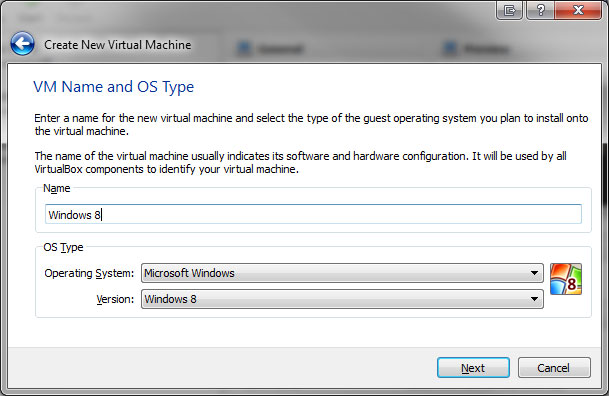
- A series of other screens will show up in the wizard. Just accept the default settings for each one unless you know what you’re doing and want to change a setting. On the final screen, check the Summary of the settings you just created and then click the “Complete” button.
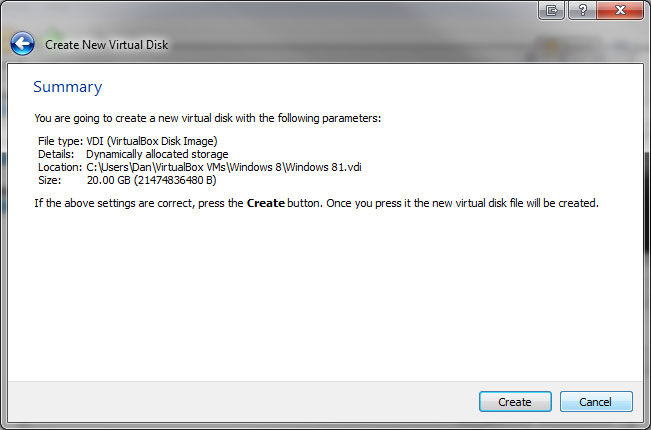
- Now you will be returned to the main screen for VirtualBox, and your new Windows 8 virtual machine will appear in the left sidebar. Your virtual machine is not quite ready to use yet though. We have to load the ISO file into the virtual CD/DVD drive actually install the operating system.Click on the “Settings” button at the top of the screen again

- Now go to “Storage” on the left sidebar and then from the storage screen click on the “Add CD/DVD Device” icon next to IDE drive (the first icon to the right).
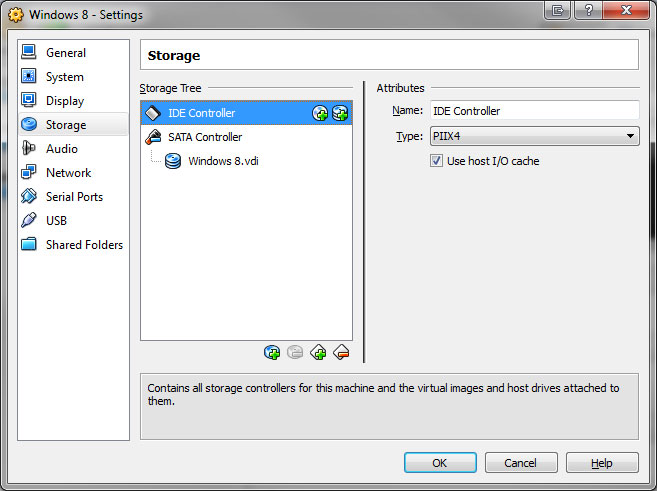
Then a pop-up window will appear asking you to select the disk you want to use. Select “chose disk” and then navigate to where you saved your Windows 8 ISO image in Step 2.
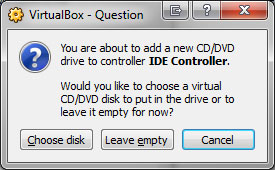
- Once you’ve selected your disk image, you should be back to the main VirtualBox screen, and see your Windows 8 virtual machine in the left sidebar. Double click on it and your Virtual Machine will load.
4. Install Windows 8
Follow the Windows 8 install procedure to install the operating system into your new virtual machine. Be sure to have the product code handy that you saved earlier, as you’ll need it here.
Upon finishing the install, you’ll be greeted by the new Windows 8 start screen.
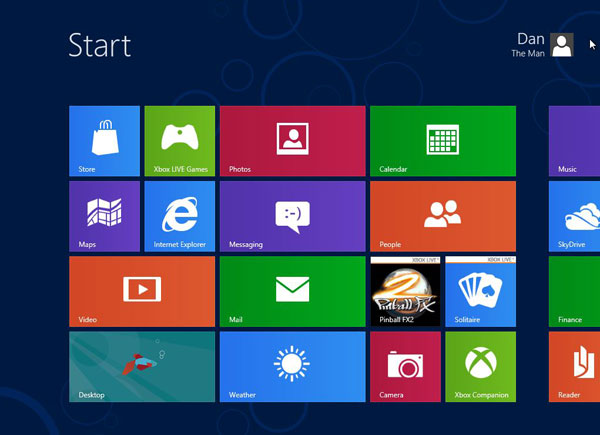
5. Give Windows 8 a try
You can now run VirtualBox and launch your Windows 8 machine anytime you want to play with Windows 8. You can modify the settings of your virtual machine if you want to make it run full screen, or make any other modifications to the way it runs.
Once you’ve got Windows 8 installed, I’d love to know what you think of the new Metro UI and the lack of a Start button on the desktop.
December 8, 2012 @ 9:13 am
But can this run on my mac?
December 8, 2012 @ 2:59 pm
I’ve never tried VirtualBox on a Mac. Their website says there is a version for OSX. Why don’t you give it a try and let me know how it works?
March 28, 2012 @ 7:48 am
VirtualBox seems to be a great tool and exactly what I was looking for. Great to see another awesome tutorial from you, Dan! Thank you!
March 28, 2012 @ 7:09 pm
Thanks Cosmin! VirtualBox is a great tool. I use it on my main computer to run Windows 8, Ubuntu, LinuxMint and CentOS. I am surprised Oracle gives it away for free.
March 23, 2012 @ 12:11 pm
I once considered installing the Win8 beta, but was worried I won’t be able to revert back to 7 if need be, since I do not have its CD.
Looks like this will solve that concern.. correct?
March 25, 2012 @ 2:30 am
That’s correct Emmanuel. You’ll essentially be able to run this version of Windows like a separate application. Your Windows 7 setup won’t be modified at all, and when you are done it’s easy to just delete the virtual machine.
Let me know how you like it.